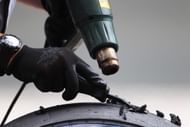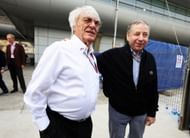Pirelli entered the sport with a very clear brief: design, build and supply tyres that degrade more quickly and produce more exciting racing. Pirelli have certainly fulfilled that brief, moving the sport away from the situation it experienced with highly durable Bridgestone tyres following the end of the tyre wars. We now generally see two or three pit-stops for all cars during each grand prix and, because of the different car and driver characteristics, tactics and tyre choices, more overtaking. Overtaking was also boosted by the introduction of the Drag Reduction System (DRS) at the start of 2011, which allows drivers who are within a second of the car in front to reduce drag by opening a flap in their rear wing at designated sections of each track, increasing acceleration and top speed.

A Pirelli technician works on a tyre during practice for the European Formula One Grand Prix in 2011. (Getty Images)
So now we find ourselves in a situation where there is overtaking in Formula 1, but that there is criticism that it is too artificial. DRS certainly receives some of this criticism, but the majority of the flack has been aimed at Pirelli. The Italian tyre manufacturer has, in each of the three years it has been supplying F1 tyres, produced rubber with rear characteristics that are more and more extreme, with drivers having to conserve their tyres, not pushing flat-out for fear that the tyres will “fall off the cliff” – a characteristic where the Pirellis simply run out of grip.
Last season, seven time world drivers’ champion Michael Schumacher described driving on the Pirelli tyres as like driving on “on raw eggs.” He elaborated on this point, explaining that the tyres were, in his view “playing a much too big effect because they are so peaky and so special that they don’t put our cars or ourselves to the limit…I don’t want to stress the tyres at all. Otherwise you just overdo it and you go nowhere.”
The situation is even worse in 2013, with the Mercedes cars of Nico Rosberg and Lewis Hamilton, in particular, struggling with some extreme tyre wear. Mercedes are by no means alone in their struggles, with Red Bull Racing being quite vocal in stating that the Pirelli tyre wear left them unable to show the underlying pace of their car. Indeed, some of the “overtaking” which has resulted from the faster wearing Pirelli rubber is, in fact, artificial given that drivers are not fighting each other for fear that they will ruin their tyres and cost themselves time. When one driver is effectively waved through by another it’s not really overtaking.
Returning to the point that I made in my opening paragraph, we are in a situation where Pirelli has delivered what they’ve been asked to deliver, but in doing so, has given us more overtaking, but artificial racing. Pirelli has clearly gone too far with their 2013 tyres, but the Italian manufacturer is an easy target for critics. If you look beyond the obvious and remind yourself of the sport’s recent history, you can see why we have arrived where we are now. The real blame, however, must lie with Formula 1’s governing body, the FIA, which sets the sport’s rules.
Surely it would have been better to continue with more durable tyres and introduce a mandatory number of pit-stops in each race, perhaps during specific parts of the race, as has been done in series like GP2. Drivers could race hard, and there would be a guaranteed number of pit-stops in each race to keep things interesting and create opportunities for strategy to be used to facilitate overtaking through pit stop phases of the race. Although this would address the tyre wear issue, the underlying problem in F1 would be unresolved.

F1 supremo Bernie Ecclestone (L) with F.I.A. President Jean Todt have lots to answer for. (Getty Images)
The fundamental issue with modern Formula 1 cars: their aerodynamic characteristics do not lend themselves to running closely together, meaning that overtaking is incredibly tough. The FIA has come up with “band aid” solutions like DRS and fast wearing tyres without, in my view, addressing this issue. As a result we have racing that is seen as artificial, Formula 1 drivers that are unable to race and push the limits of their machinery, and ridiculous situations like the Pirelli/Mercedes/Ferrari tyre testing controversy that erupted at the recent Monaco grand prix.
All of this is a turn off for F1 fans. Don’t get me wrong, I still wouldn’t miss a race, but I find myself distinctly underwhelmed by the Formula 1 of 2013. Surely it’s not beyond the technical geniuses of Formula 1 to come up with a properly thought out solution to these issues? In any case, the sport will be undergoing some significant changes in 2014 with the advent of the new turbocharged era. I’m looking forward to the unpredictability that the 2014 regulation change will bring, but I do worry that the underlying issues will remain.
Whatever the case, I can’t help but feel that 2013 will be dominated by tyre controversies. With Pirelli’s contact up for renewal at the end of the season, F1 could find itself in a situation where the Italian manufacturer decides to walk away. The sport would only have itself to blame.
